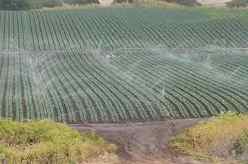
Hundreds of farmers around the state are upgrading their irrigation systems with the financial support of a California Department of Food and Agriculture grant program for projects that improve water and energy efficiency, and reduce greenhouse gas emissions. Not only will farmers be now able to lower the stress and gain more control of their machines with a VFD drive but also with the help of better technology they can now measure the soil for various elements and ensure better quality crops.
CDFA awarded $10 million in 2014 to help more than 130 growers improve their irrigation through the State Water Efficiency and Enhancement Program, and announced an additional 100 projects for 2015 awards last week.
One of the 2014 awards helped finance a weather station at Rio Viente Vineyards near the Sacramento River in Walnut Creek.
“That provides the Et data,” said Jamie Reamer, who oversees irrigation at the family vineyard, as she pointed toward the weather station. “Every Wednesday, I look at the Et for the previous week and talk to the viticulturist.”
While the weather station provides evapotranspiration data, sensors buried in the ground at each block radio back soil moisture data for every four inches to a depth of four feet.
The combination of the two sorts of information lets Reamer devise a precise irrigation program, and monitor whether there are problems that need to be addressed.
“The Et tells me how much water to apply, and the soil sensors tell me how to apply it,” she said. “What I’ve learned with the sensors is every block has its own story. One block has infiltration problems, where the water goes down to a foot and stops; this lets me try different solutions and see how they’re working. Another block hits peat at 20 inches, and I know not to run long sets. It’s learning to apply water in sets of duration that make sense.”
The combination of instruments and transmitters makes information easily on hand every day that would otherwise only be available through considerable effort at each vineyard block.
“You can auger the ground, but you’re not going to auger every day,” Reamer said. “I can sit at my desk 22 miles away and decide how long to run the water. The in-line pressure sensors tell me if the blocks are irrigating properly or if there is a problem in the line.”
CDFA has helped other farmers install equipment that gives them more precise information to guide irrigation decisions.
Daniel Jackson installed a system to monitor soil moisture through sensors with electronic data output and flow meters to ensure efficient irrigation scheduling at his Family Tree Farms in Tulare County.
Four Oaks Farming in San Benito County installed equipment to test soil moisture levels, and onsite weather and CIMIS requirements to improve irrigation efficiency of its organic walnut orchard.
And Six K’s Orchards in Butte County converted from flood irrigation to efficient micro-jet irrigation with solar panels to run the water pump.
The awards, made available through the Greenhouse Gas Reduction Fund, the proceeds of California’s greenhouse gas cap-and-trade program, are for a maximum of $150,000 per project.
“We have money to give out to save water and reduce greenhouse gases,” said Amrith Gunasekara, CDFA science advisor. “It uses greenhouse gas reduction funds.”
Funds have been awarded to highly established firms and beginning farmers, for highly sophisticated technical improvements and for relatively simple water storage projects.
At the 4,200-acre Scheid Vineyards outside Greenfield, SWEEP funds helped finance irrigation and fertilizer automation equipment, soil and microclimate monitoring equipment, and a variable-frequency drive for pumping efficiency improvements.
SWEEP funds last year also helped a complex of small farms just outside Davis put real-time moisture sensors in the ground for four crops, retrofit automatic irrigation on two pumps, install a gray water system to irrigate existing blackberry fields and a vegetable plot, and install solar panels to replace a three-horsepower gasoline-powered pump.
“The panels power one of the pumps that irrigate vegetables, melons and blackberries,” said Emma Torbert, one of the principals at the Cloverleaf Farm tree fruit orchard.
In addition to buying hardware, the SWEEP grant funds also pay off by encouraging farmers to devote their precious management time to learning as much as possible about irrigation and energy efficiency.
“One of the good things about the grant was having all of us farmers brainstorm about ways to save water and energy,” Torbert said. “We thought of ways to save water that didn’t cost anything.”
One of the rows at the Cloverleaf orchard, for example, was left without weed-suppressing mulch as an experiment in how much water the mulch saves.
The sophisticated moisture sensors and weather station at the Rio Viente Vineyard have also set in motion a learning process.
“I’m using Et, and that’s the most important thing, but I’m still learning,” Reamer said. “One of the things I’m working on is calibrating the point where we have the sensors to the rest of the block.”
By Bob Johnson, from Ag Alert and the California Farm Bureau Federation









